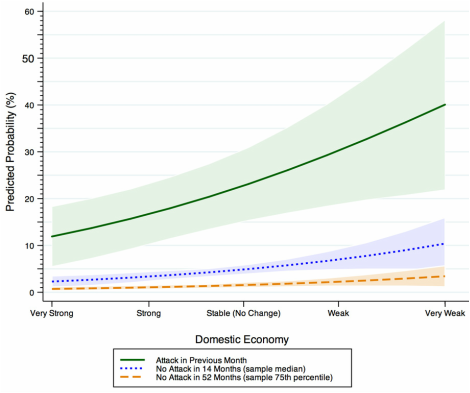Alternative Politicking: Terrorism is a Mechanism for Political Mobilization
Committee: David H. Clark (Chair), Patrick M. Regan and Benjamin O. Fordham
Transnational terrorism maximizes the probability of successful provocation and retaliation (i.e. a government behavior that can radicalize moderates) by strategically targeting states where leaders already have incentives for political use of force. In this sense, transnational terrorists are conflict-seeking actors. In a piece in the Washington Post I apply my dissertation research to explain why ISIS attacked Paris on November 13th. My guest post on Political Violence @ A Glance discusses the dynamic relationship between a country's risk from transnational terrorism and the 'traditional' incentives for political use of force. Ultimately, when political elites are forced to address a declining economy or divert the public's attention with aggressive foreign policy, the country's risk from transnational terrorism increases, on average, by 14%. The graph below depicts changes in a country's risk of transnational terrorism across the current condition of the economy and time since the previous terror attack.
Committee: David H. Clark (Chair), Patrick M. Regan and Benjamin O. Fordham
Transnational terrorism maximizes the probability of successful provocation and retaliation (i.e. a government behavior that can radicalize moderates) by strategically targeting states where leaders already have incentives for political use of force. In this sense, transnational terrorists are conflict-seeking actors. In a piece in the Washington Post I apply my dissertation research to explain why ISIS attacked Paris on November 13th. My guest post on Political Violence @ A Glance discusses the dynamic relationship between a country's risk from transnational terrorism and the 'traditional' incentives for political use of force. Ultimately, when political elites are forced to address a declining economy or divert the public's attention with aggressive foreign policy, the country's risk from transnational terrorism increases, on average, by 14%. The graph below depicts changes in a country's risk of transnational terrorism across the current condition of the economy and time since the previous terror attack.
Predicted Probability of Being the Target of Transnational Terrorism Across Unemployment Difference (95% Confidence Intervals)
Domestic terrorism follows a different logic and reflects a strategy of retribution. Government repression of political protesters creates an opportunity for domestic terrorists to signal their ability to punish the state and provide aggrieved civilians an opportunity for retribution. Strategic target selection remains important. To accomplish radicalization objectives, following the government's beating, shooting or killing of protesters, domestic terrorism shifts to attacking government targets and away from civilian targets. Additionally, to keep the government the focus of grievances and vengeance and avoid becoming the primary source of outrage, domestic terrorists reduce the human toll of attacks when pursuing a strategy of retribution. My statistical analysis shows that following government repression of protesters, the next chronological domestic terror attack is more likely to target the government and that the casualty rate decreases by 44%.

